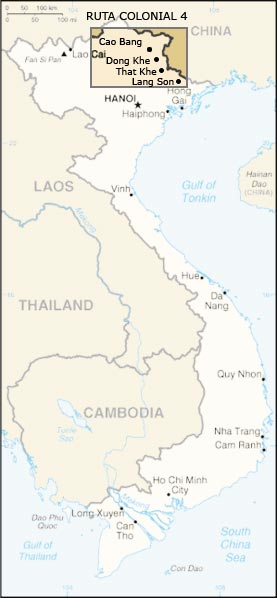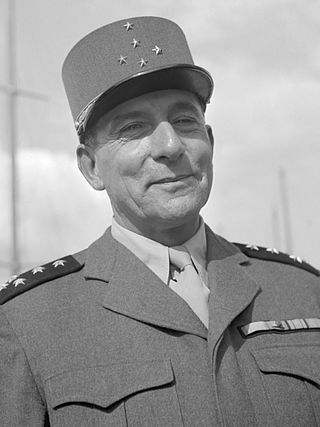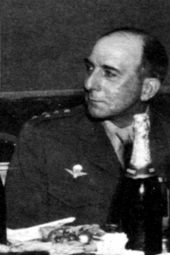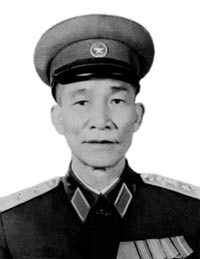
The Battle of Điện Biên Phủ was a climactic confrontation of the First Indochina War that took place between 13 March and 7 May 1954. It was fought between the French Union and communist Viet Minh.

The Battle of Route Coloniale 4, also called the Autumn-Winter Border Campaign by the Viet Minh, was a battle of the First Indochina War. It took place along Route Coloniale 4, a road used to supply the French military base at Cao Bằng. French military traffic along the road had previously been subject to an ongoing series of ambushes during 1947–1949.

The First Indochina War was fought between France and Việt Minh, and their respective allies, from 19 December 1946 until 21 July 1954. Việt Minh was led by Võ Nguyên Giáp and Hồ Chí Minh. Most of the fighting took place in Tonkin in Northern Vietnam, although the conflict engulfed the entire country and also extended into the neighboring French Indochina protectorates of Laos and Cambodia.

Jean Joseph Marie Gabriel de Lattre de Tassigny was a French général d'armée during World War II and the First Indochina War. He was posthumously elevated to the dignity of Marshal of France in 1952.

Lieutenant General Sylvain Trần Văn Minh was a Vietnamese diplomat and a general of the Army of the Republic of Vietnam.
Operation Léa was a French Union military operation between 7 October and 8 November 1947 during the First Indochina War. It is also known as the Việt Bắc Campaign by the Viet Minh. It was an attempt by the French General Valluy to crush the Việt Minh. An airborne force would capture the Việt Minh leadership and three French columns would strike into the Việt Minh heartland.
The Battle of Vĩnh Yên which occurred from 13 to 17 January 1951, was a major engagement in the First Indochina War between the French Union and the Việt Minh. The French Union forces, led by World War II hero Jean de Lattre de Tassigny, inflicted a decisive defeat on the Việt Minh forces, which were commanded by Võ Nguyên Giáp. The victory marked a turn in the tide of the war, which was previously characterized by a number of Việt Minh victories.
The Battle of Mạo Khê, occurring from March 23 to March 28, 1951, was a significant engagement in the First Indochina War between the French Union and the Việt Minh. The French Union forces, led by World War II hero Jean de Lattre de Tassigny, inflicted a defeat on Việt Minh forces, which were commanded by General Võ Nguyên Giáp. The French Union victory, however, was not decisive and the Việt Minh would attack again shortly afterwards.

Operation Lorraine was a French Union military operation of the First Indochina War.
The Battle of Hòa Bình was fought during the First Indochina War. It occurred from 10 November 1951 to 25 February 1952, when French Union forces attempted to lure the Việt Minh out into the open and to force it to fight on French terms.

The Battle of Nà Sản was fought between French Union forces and the communist forces of the Việt Minh at Nà Sản, Sơn La Province, during the First Indochina War for control of the T’ai region.

The Vietnamese National Army was the State of Vietnam's military force created shortly after the Élysée Accords, where the State of Vietnam was recognized by France as an independent country ruled by Vietnamese Emperor Bảo Đại. It was commanded by Vietnamese General Hinh and was loyal to Bảo Đại. The VNA fought in joint operations with the French Union's French Far East Expeditionary Corps (CEFEO) against the communist Việt Minh forces led by Ho Chi Minh. Different units within the VNA fought in a wide range of campaigns including the Battle of Nà Sản (1952), Operation Hautes Alpes (1953), Operation Atlas (1953) and the Battle of Dien Bien Phu (1954).

Operation Mouette was an operation in 1953 by the French Union Army in Northern Vietnam during the First Indochina War. It was launched on October 15 in an attempt to locate and destroy Viet-Minh Chu Luc troops operating under the command of Võ Nguyên Giáp around the area of Phu Nho Quan, south of the Red River Delta. Following the establishment of a French camp in the area, various troops were dispatched to engage the Viet-Minh forces. The operation was ended and the French withdrew by November 7, claiming approximately 1,000 enemy combatants killed, twice as many wounded, and 181 captured as well as a substantial quantity of weapons and ammunition.
The 308th Infantry Division is a division of the People's Army of Vietnam (PAVN), first formed in August 1950 in southern China from the previous Regimental Group 308.

The Battle of the Day River took place between late May and early June 1951, around the Day River Delta in the Gulf of Tonkin. Part of the First Indochina War, the battle was the first conventional campaign of Võ Nguyên Giáp, and saw his Việt Minh People's Army of Vietnam (VPA) forces tackle the Catholic-dominated region of the Delta in order to break its resistance to Việt Minh infiltration. On the back of two defeats at similar ventures through March and April that year, Giap led three divisions in a pattern of guerrilla and diversion attacks on Ninh Bình, Nam Định, Phủ Lý and Phat Diem beginning on May 28 which saw the destruction of commando François, a naval commando.
The 320th Division or Đồng Bằng Division is a formation and one of the six original "Steel and Iron Divisions" of the People's Army of Vietnam (PAVN). It was established in January 1951.
The Battle of Nghĩa Lộ, also called Ly Thuong Kiet Campaign by Việt Minh, was fought between the French Union army and the Việt Minh during the First Indochina War. Both general Giap and de Lattre waited eagerly for the battle due to the postponement that occurred when Giap's attack along the Day River were driven back in June 1951. Since Giap was the one controlling the tempo of this war for months, it took a huge turn during the pause after his defeat causing his military situation to become unstable. On 3 October, the Việt Minh 312th Division launched an attack on French forces in the town of Nghĩa Lộ and its vicinity which was led by the general Giap. This attack on Nghĩa Lộ occurred 95 miles west of Hanoi and only 65 miles past that of the western de Lattre Line. This village was the utmost importance to de Lattre because it served as the capital of the T'ai natives which had very strong ties with the French. The first attacked was carried out by two regiments of the 312th Division to the surrounding posts that acted as the main defense of the town in order to maintain military control. Since de Lattre was not present at the time, General Salan took the reins of the situation and quickly reinforced the surrounding posts with paratroopers carried by parachutes to fortify defenses. This quick strategy by General Salan was looked upon the saving grace of this battle since it repelled a secondary attack by two regiments of the 312th Division that same night. Additional reinforcements occurred during the 4th of October along with air support which led to General Giap to call off his attack which they then fled across the Red River. A year later on 17 October, the Việt Minh launched another attack on Nghĩa Lộ and succeeded in driving out the remaining French from the area.

The 316th Division or Bông Lau Division was a division of the People's Army of Vietnam (PAVN). One of the 6 original "Steel and Iron Divisions", it was created in 1951 and consisted of some 10,000 to 15,000 men.

Operation Pollux was a military operation during the First Indochina War by the French Union forces in northwest Vietnam in November and December 1953 was one of a twin operation, the other being Operation Castor. The names of these operations are based upon the mythological twins, Castor and Pollux. Operation Castor recaptured and then established a fortified airfield in Điện Biên Phu, in the north-west corner of Vietnam. Operation Pollux was the name of the second operation, which took place weeks later. These operations were developed by General Navarre who had replaced General Salan as Commander in Chief in early 1953 after the Viet Minh had conducted their successful offensive in the Black River area of northwest Vietnam and then subsequently invaded Laos in April 1953.

Vương Thừa Vũ (1910-1980) was a lieutenant-general in the People's Army of Vietnam active during World War II, the First Indochina War, and the Vietnam War. He commanded Viet Minh forces in their early engagements at Hanoi in 1946, directing the city's two month-long defence against French forces. By 1949, during the Viet Minh's transition from guerrilla to regular warfare, he had risen to command the PAVN's first modern infantry division, the 308th, which he led into battle at Dien Bien Phu in 1954.











